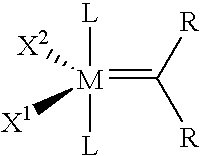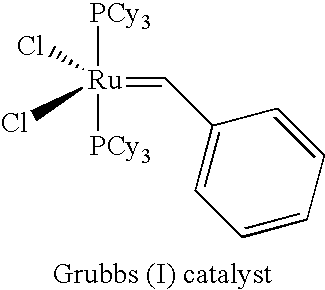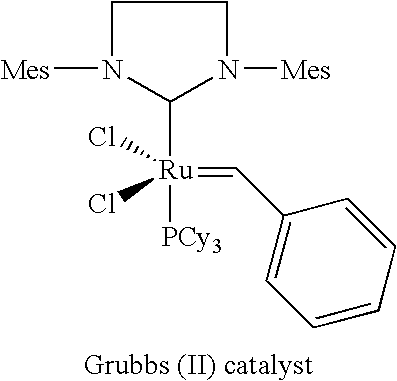Catalyst Systems and their use for Metathesis Reactions
a catalyst system and catalyst technology, applied in the field of catalyst systems, can solve the problems of inability to achieve, substantially alter the microstructure of the polymer, and limit the processingability of hnbr grades having the abovementioned relatively high mooney viscosity, so as to increase the reaction rate of metathesis reactions, reduce the molecular weight of nitrile rubber by metathesis, and increase the effect of catalyst activity
- Summary
- Abstract
- Description
- Claims
- Application Information
AI Technical Summary
Benefits of technology
Problems solved by technology
Method used
Image
Examples
examples
[0354]When the following examples are carried out at room temperature, this is 22+ / −2° C. In the examples below, the complex catalysts shown in Table 1 were used.
TABLE 1Molecular weightName of catalystStructural formula[g / mol]SourceGrubbs II Catalyst848.33Materia / Pasadena; USAHoveyda Catalyst626.14AldrichGrela Catalyst671.13Prepared as described in J. Org. Chem. 2004, 69, 6894-6896
[0355]The following examples according to the invention were carried out using the compounds of the general formula (Z) shown in Table 2.
TABLE 2Name of additiveFormulaSourceDiethyl ether adduct of boronBF3*C4H10OAcrostrifluorideOrganicsEthylamine adduct of boron trifluorideBF3*EtNH2AldrichTetrahydrofuran adduct of boronBF3*C4H8OAldrichtrifluoriden-Propanol adduct of boron trifluorideBF3*C3H7OHAldrichAcetic acid adduct of boron trifluorideBF3*CH3COOHAldrich
[0356]The examples carried out on the metathetic degradation of nitrile rubber are summarized in terms of the complex catalysts used, the compound of th...
PUM
| Property | Measurement | Unit |
|---|---|---|
| molecular weight distribution | aaaaa | aaaaa |
| polydispersity index PDI | aaaaa | aaaaa |
| polydispersity index PDI | aaaaa | aaaaa |
Abstract
Description
Claims
Application Information
 Login to View More
Login to View More - R&D
- Intellectual Property
- Life Sciences
- Materials
- Tech Scout
- Unparalleled Data Quality
- Higher Quality Content
- 60% Fewer Hallucinations
Browse by: Latest US Patents, China's latest patents, Technical Efficacy Thesaurus, Application Domain, Technology Topic, Popular Technical Reports.
© 2025 PatSnap. All rights reserved.Legal|Privacy policy|Modern Slavery Act Transparency Statement|Sitemap|About US| Contact US: help@patsnap.com



